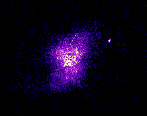Shedding a New Light on the Universe
The Crab Nebula in Different Energies
What specific information can observation in different energies give us? Let's examine the Crab Nebula; it is unique in that it contains one of only a few pulsars that are observable at so many different energies.
The Crab Nebula's creation was witnessed in July of 1054 A.D. when Chinese astronomers and members of the Native American Anasazi tribe separately recorded the appearance of a new star. Although it was visible for only a few months, it was bright enough to be seen even during the day! In the 19th century, French comet hunter Charles Messier recorded a fuzzy ball of light near the constellation Taurus. This fuzzy ball turned out not to be a comet after all, but the remains of a massive star whose explosive death had been witnessed centuries before by the Chinese and the Anasazi.

Scientists now believe the Crab Nebula is the remains of a star which suffered a supernova explosion. The core of the star collapsed and formed a rapidly rotating, magnetic neutron star, releasing energy sufficient to blast the surface layers of the star into space with the strength of a 1028 megatons (a nuclear bomb is about 10 megatons). Nestled in the nebulous cloud of expelled gases, the rotating neutron star, or pulsar, continues to generate strobe-like pulses that can be observed at radio, optical, and X-ray energies. The Crab Nebula was one of the first sources of X-rays identified in the early 1960s when the first X-ray astronomy observations were made.

|
At radio wavelengths, the Crab Nebula, seen to the left, displays two distinctive physical features. The nebulous regions hide radio emission coming from unbound electrons spiraling around inside the nebula. The pulsar at the heart of the Crab Nebula generates pulses at radio frequencies roughly 60 times a second. In this image, the pulsar's flashes are blurred together (since the image was "exposed" for much longer than 1/60 s) and it appears as the bright white spot near the middle of the nebula.
|
|
In the optical, both a web of filaments at the outer edges of the nebula and a bluish core become apparent. The blue core is from electrons within the nebula being deflected and accelerated by the magnetic field of the central neutron star. The filaments surrounding the edges of the nebula are the remnants of the original outer layers of the star.
|

|

|
In the ultraviolet (or UV) the nebula is slightly larger than when seen in X-rays. Cooler electrons (responsible for the UV emission) extend out beyond the hot electrons near the central pulsar. This supports the theory that the central pulsar is responsible for energizing the electrons.
|
|
X-ray observations reveal a condensed core near the central pulsar, which is the bright dot visible slightly left and below center in the image to the right. The Crab Nebula appears smaller and more condensed in X-rays because the electrons which are primarily responsible for the X-ray emission exist only near the central pulsar. Scientists believe that the strong magnetic field near the surface of the neutron star "heats up" the electrons in it and that these "hot" electrons are responsible for the X-ray emission.
|

|

Previous |

Next |


